Myth busting: Density and wellbeing
With over 55% of the world’s population now living in urban areas, the issue of density has never been more relevant. But are density and wellbeing exclusive, or is the relationship more complex than that?
In September 2020, Director Félicie Krikler and Head of Wellbeing Ben Channon were invited to take part in a discussion organised by LD Events to bust the myth that density equals worse health and wellbeing outcomes.
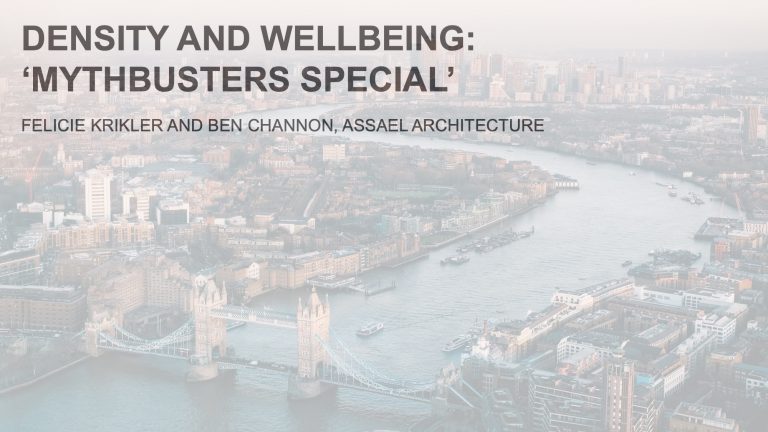
Density is certainly an important part of our brief from clients; designing residential developments that are economically viable, efficient, that will get planning, but most importantly that will become great places to live, now and in the future.
At this moment in time, we probably more than ever before all understand the real importance of creating homes that are places in which we want to spend time, relax, raise our families and work.
So how do we balance development density and designing places that deliver the wellbeing we are all after? And are the two compatible?
To start with, here’s an overview of what is new for architects in the last year relating to density in the planning world.
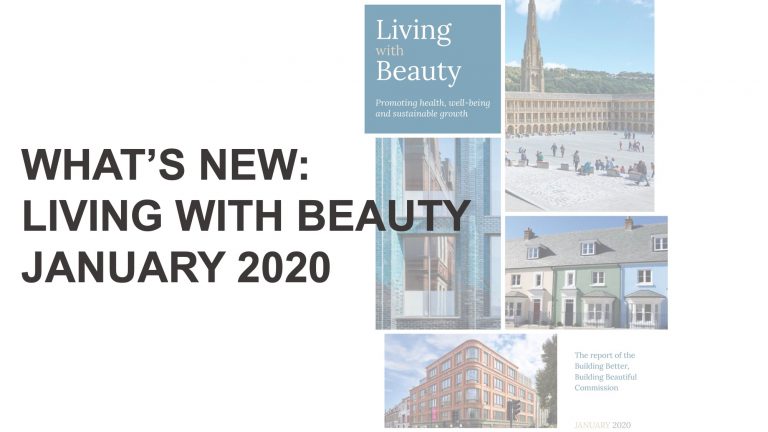
Firstly, we saw the publication of the Living with Beauty report back in January. It was prepared by the Building Better, Building Beautiful Commission (BBBBC) and sets out its recommendations to government on how to promote and increase the use of high-quality design for new build homes and neighbourhoods.
It proposes three aims for the planning system:
- Ask for Beauty
- Refuse Ugliness
- Promote Stewardship
The report proposes 45 recommendations for the National Planning Policy Framework (NPPF), as well as other national planning guidance documents, including policy alterations and propositions that aim to implement requirements for good building design, with an emphasis on the importance of placemaking and putting design quality in the spotlight.
The word density is mentioned 37 times in the 190 pages of the report. It promotes the idea of what it calls ‘gentle density’ – mansion blocks and terraced housing rather than semis and towers.

Then in August, the white paper was published that proposes some significant changes to the planning system with the aim to deliver more homes that are affordable and built faster, but the paper also puts a real emphasis on quality.
The new system proposes a standardisation and centralisation of the development management policies that can be repetitive across different local plans and between national and local policy. The NPPF would become the main place to look for specific development management standards.
The local plan would develop plans and codes for land to be designated in three different categories:
- Growth areas
- Renewal areas
- Protected areas
It would set design codes that define building heights, density and volume, and potentially go as far as determining appropriate materials and street design.
Another vital point that the white paper recognises is the importance of the quality of the places where we live and their impact on our wellbeing:
“Where we live has a measurable effect on our physical and mental health: on how much we walk, on how many neighbours we know or how tense we feel on the daily journey to work or school. Places affect us from the air that we breathe to our ultimate sense of purpose and wellbeing.”
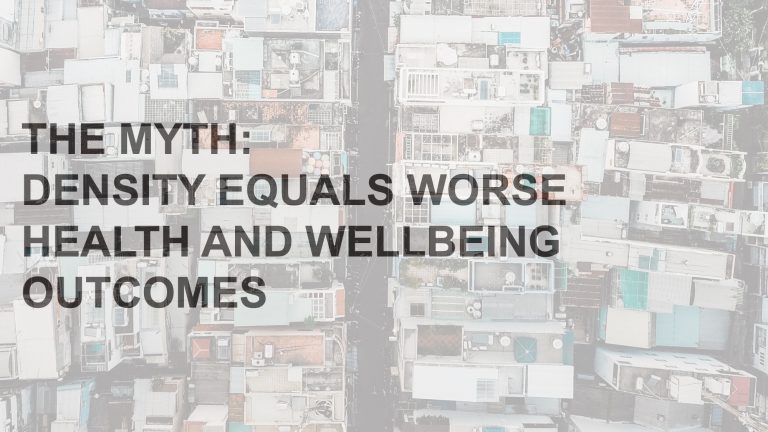
We’re often led to believe that density equals worse health and wellbeing outcomes.
The phrase ‘gentle density’ has become something of a buzzword in the last couple of years, suggesting that ‘genuine’ density leads to worse places. Certain groups within planning and on social media have also been fairly critical of density in recent years, so we wanted to look more closely at density and try to understand the positive impacts it can have on our mental health too.
So what are the benefits of density on wellbeing?
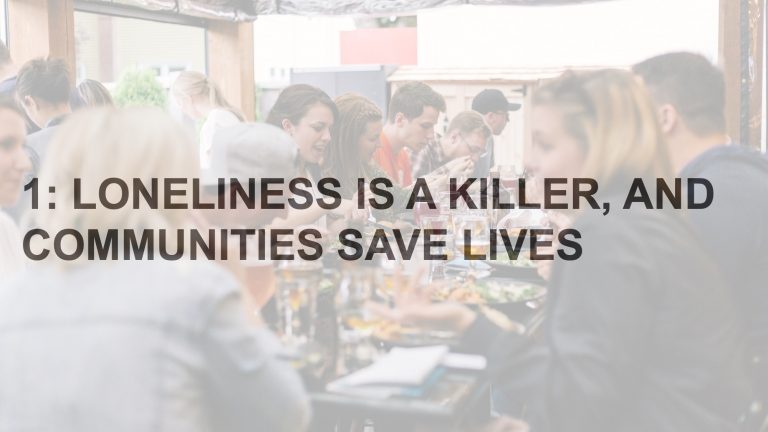
Loneliness
One of the first ways that density can actually be beneficial for our mental and physical health is the increased ability it gives us to connect to other people. It isn’t often talked about, until recently during lockdown, just how bad loneliness can be for our wellbeing. The Campaign to End Loneliness has reported that being chronically lonely increases mortality rate by 26%, making it comparatively as bad for you as obesity or smoking 15 cigarettes a day. It also puts us at greater risk of cognitive decline, dementia, depression and suicide. So, all in all, the health impacts of being lonely or isolated can be enormous.
And density offers greater opportunities for social interaction, although design of course plays a key role in this. We see many developments now where, for example, people can only access their own floor via a key fob; in the rush to improve security, there are concerns that we are losing some of the social benefits of living in denser schemes.
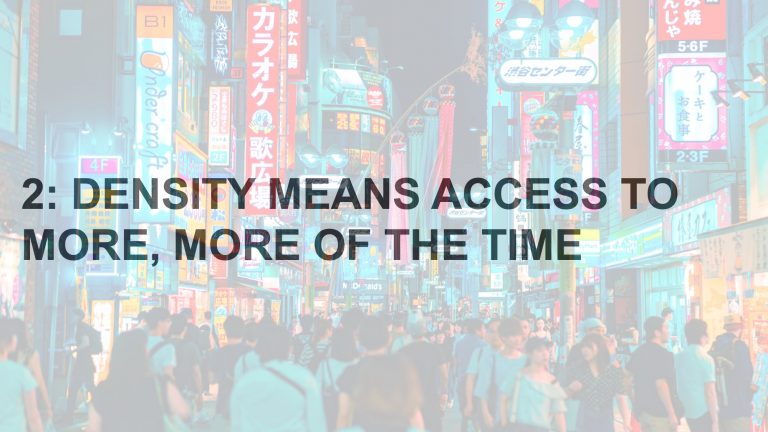
Amenity
One of the big upshots of increasing density is the ability to create and support a wider range of amenities, whether it’s shops, galleries, cinemas or places to eat. We only have to look at London, which in 2013 had 241 of the UK’s 1,100 theatres – meaning over a fifth of all theatres were located in just one dense city.
Furthermore, research shows that amenities matter when it comes to how highly we rate a place to live in. A study by the American Enterprise Institute found that people who live in amenity-packed neighbourhoods are more likely to feel a sense of community and community satisfaction, with 45% of people in high-amenity neighbourhoods rating their community as an excellent place to live, compared to just 26% of those who live in low-amenity neighbourhoods.
Interestingly, going back to the previous point on isolation, that same report looked at the relationship between amenity and loneliness too, and found that 55% of respondents in low-amenity suburbs felt a high degree of social isolation, while less than one-third of respondents in amenity-dense neighbourhoods felt isolated. They also found that people who live in amenity-dense places are twice as likely to talk to their neighbours on a daily basis than those who live in an area with fewer amenities.
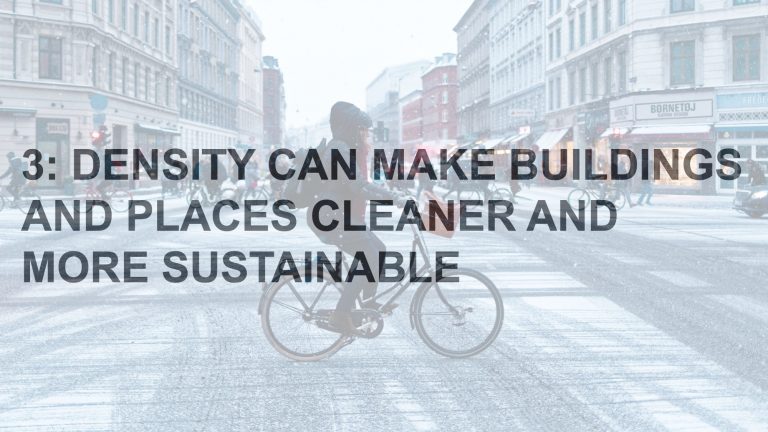
Sustainability
One of the big claims that’s often made in favour of density is that it makes places more sustainable. This is a really important issue when we talk about mental wellbeing, with a growing number of people seeking help for ‘eco-anxiety’; in a recent survey, over three quarters of students said that thinking about climate change made them anxious.
Thankfully, when we dig into the facts behind this, we find that generally density does mean greener places. Of course, tall buildings tend to be rather carbon heavy in terms of materials, but when we look at whole lifecycle costs, cities really are greener than their rural counterparts. In his book ‘Green Metropolis’, David Owen celebrates Manhattan, explaining that smaller homes and the use of mass transit has surprisingly made it the cleanest place in America.
Denser buildings and settlement patterns yield energy savings, meaning lower carbon emissions and cleaner air, particularly when combined with a reduction in car use that can occur with density. Given that around 65,000 people a year die from poor air quality, this obviously creates a very strong case for density from a wellbeing perspective.
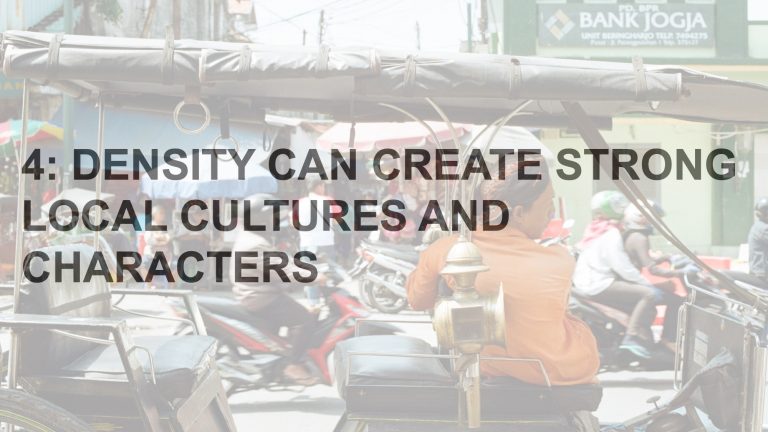
Culture and character
Another important bonus of creating denser places is that it can help to create diverse places with strong characters and a sense of local identity. There is strong evidence that the presence of local character encourages community life, which, as already mentioned, can improve mental health and reactivates people’s sense of identity with their particular neighbourhood.
The presence of distinct localities within a city also helps to satisfy growing demands for greater choice and for diversity over standardisation. We know that giving people more choice and control over their environment makes them feel better, so this has a significant wellbeing benefit too.
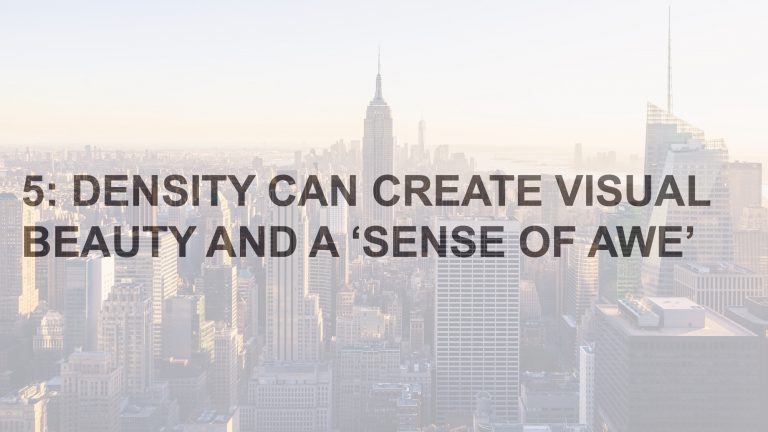
Visual beauty and awe
We’ve all seen density done badly, but anyone who’s been to New York, Tokyo, Barcelona or Rio de Janeiro can attest to the way that density can create its own beauty and inspire a sense of awe, which we know plays an important role in our mental wellbeing. Most studies show a correlation between happiness and living in a ‘beautiful place’, so this has its own benefits to how we feel on a daily basis.
There has also been fascinating research carried out on this idea of a ‘sense of awe’, whether we get it from standing under an enormous waterfall or at the foot of the Petronas Towers. Researchers found that jaw-dropping moments made participants feel like they had more time available and made them more patient, less materialistic, and more willing to volunteer time to help others – all of which support better mental wellbeing.
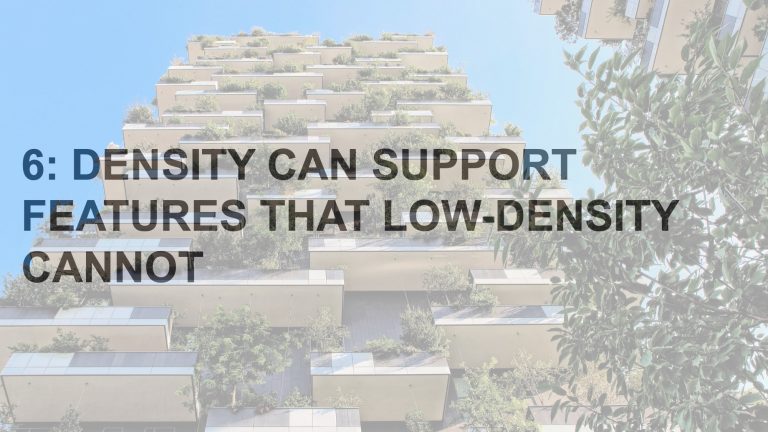
Features
With density of course comes greater land values too and the opportunity to build bigger, more ambitious projects that can potentially use higher quality materials and design features that are harder to justify on lower land-value sites. This could mean biophilic patterns or even generous planting across levels, like in the Bosco Verticale, both of which we know have significant benefits on mental wellbeing and can also have a positive impact on air quality. This could also mean things like low VOC emitting materials or MEP improvements like high spec air and water filters, which can all result in healthier homes too.

This all said, we do of course have to look at the bigger picture and be aware of some of the potential pitfalls to wellbeing associated with greater density:
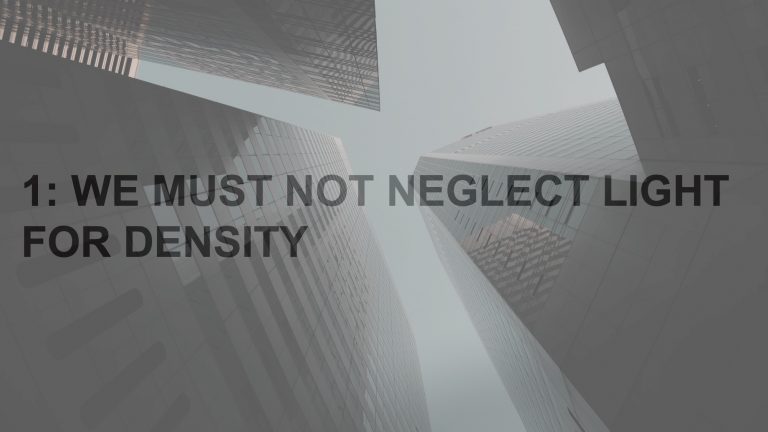
Light
Daylight plays a very important role in both our physical and mental health, and has a big impact on our sleep, so it’s really important that density does not come at the expense of natural light.

Nature
The power of nature and biophilia has already been mentioned, and while it’s absolutely possible to create density amongst greenery, it’s something we need to be aware of as we look at densification.

Privacy
Privacy is incredibly important to people’s sense of dignity and their mental wellbeing, and stripping somebody of their privacy is a guaranteed way to make them feel restricted and less happy. So, as places get denser, we need to take extra care to ensure privacy isn’t compromised.
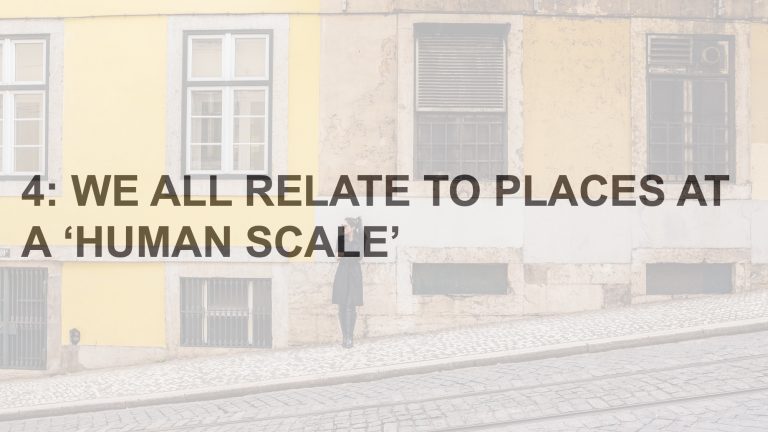
Human scale
Designers have been aware of the importance of human scale from the ancient Greeks to Le Corbusier’s Modulor Man, and with good reason, as we all experience the world at a human scale. While density and scale can be used in a positive way, it’s also really important to remember that sense of scale to avoid creating places that ignore what’s happening at street level.
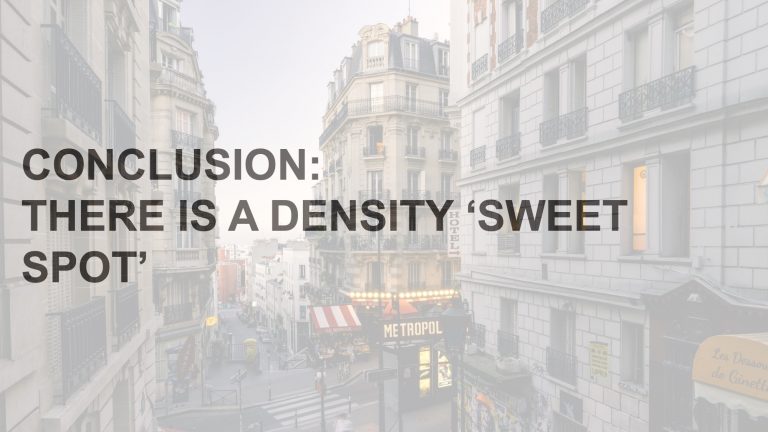
Conclusion
In summary, when talking about health and wellbeing, it seems that there is a density sweet spot – a bit of a Goldilocks principle or what they might call Lagom in Swedish – not too dense but not too sparse.
Places need to be dense enough to create strong characterful communities, support a broad range of amenities, enable sustainable living, create a sense of awe and wonder, and facilitate high-quality buildings. However, if they become overly dense without consideration for potential negative factors, they can absolutely have a negative impact on human health and wellbeing.
We personally don’t believe there’s a ‘magic figure’ as it varies based on a whole range of factors – from geography to culture – but it can certainly exceed the ‘gentle density’ idea of around 4-5 storeys and not just avoid harm to human health, but actively improve and support better wellbeing and quality of life.